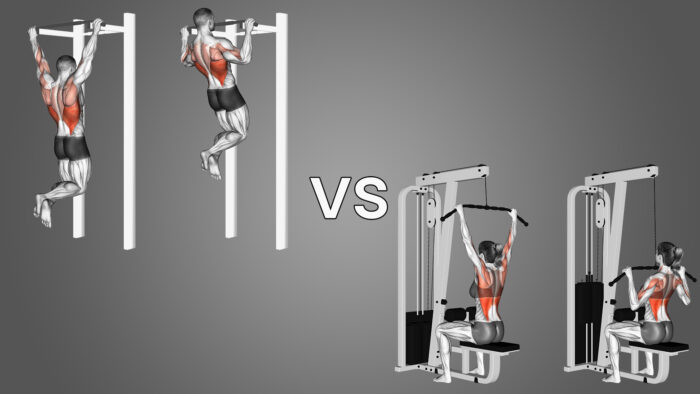Lat pulldowns and pull-ups stand as two of the most popular vertical pulling exercises for building a strong, muscular back. But each comes with its own benefits and drawbacks. So should you focus on one exercise over the other, or incorporate both into your back training?
After coaching hundreds of clients and athletes, here’s everything you need to know comparing lat pulldowns versus pull-ups for sculpting an impressive upper body:
Muscles Worked
First, let’s examine the muscles targeted by each movement. Pull-ups actively engage the lats, middle and lower traps, rhomboids, posterior deltoids, biceps, forearms, abdominals, and serratus. So they hit a very wide range of upper body musculature.
Lat pulldowns also recruit the lats as prime movers, along with the middle back, rear delts, and biceps in supporting roles. So while not as all-encompassing as pull-ups, they still stimulate substantial upper body musculature.
Range of Motion
When it comes to range of motion, pull-ups allow for a greater stretch of the lats through a fuller vertical angle of movement. Starting from a dead hang underneath the bar, you pull your chest upwards until the bar touches near your upper abdominals above for complete shoulder extension.
Meanwhile, lat pulldowns involve sitting down, already at a shortened muscle state. You pull the bar to your upper chest, but can’t extend the shoulders quite as far compared to pull-ups. So pull-ups enable more lat lengthening for superior hypertrophy results.
Loading and Progressive Overload
Here’s where lat pulldowns shine. By using an adjustable cable stack or plate-loaded machine, you can precisely load levels from very light to extremely heavy resistances. Lifting heavier weight over time fuels muscle growth. Lat pull machines accommodate beginners up to the strongest bodybuilders.
With pull-ups, you’re limited to your bodyweight for loading. While you can add weight using a belt or vest, quantifying progress doesn’t come as easily without a quantifiable external load tracking strength gains. Advanced calisthenics athletes can develop immense pull-up power, but raw beginners will struggle.
Use of Assistance
If unable to complete a pull-up yet, no amount of assistance exercises properly prepares the right muscles for the movement pattern. Lat pull machines thus help build a base of vertical pulling strength in early stage trainees until ready for free hanging pull-ups.
Pull-up alternatives like bands, assisted machines, and negatives can help build capacity. But they don’t fully mimic the core tension, scapular retraction, grip demands and exact motion of strict pull-ups through full range of motion. Still, machines help avoid wasted efforts until base strength reaches necessary levels.
Muscular Engagement
Due to the instability of free hanging pull-ups, your body must engage many smaller but essential muscles to stabilize the shoulders and spine during. Core tension, scapular control, grip strength and biceps/brachialis activation all interplay for safe, efficient technique.
In lat pulldowns, the fixed machine disperses tension evenly without as many ancillary demands. You can better isolate the lats using sound biomechanics. But some smaller muscle actions get overlooked that bolster injury resilience during real-world activities.
Functional Carryover
Speaking of real-world function, pull-ups mimic activities like climbing, swinging gymnast-style movements, and preventing falls by grasping overhead supports. The grip and upper body strength built from pull-ups transfers better to obstacle courses and tactical training compared to machines.
Then again, few daily actions require the grip endurance, wrist flexibility, and shoulder extension range achieved through pull-ups. Both have gym-specific strength benefits, but pull-ups edge out lat pulls for tangible applications.
Risk of Injury
When learning pull-ups, overuse tendonitis injuries or shoulder impingement resulting from poor technique remain concerns. If you lack the capacity to control motion eccentrically, avoid kipping, or ignore pain signals, pull-ups can harm otherwise healthy shoulders. Proper progressions are mandatory.
Conversely, lat pulldowns pose little injury risk since the fixed path of motion and external resistance minimizes sheer forces. The cushioned seat and grip variety alleviate wrist strain. For some with pre-existing shoulder troubles, machines may prove safer too.
In summary, while advanced calisthenics athletes can build extraordinary lats and upper body power using pull-ups, beginners likely need lat pulldowns to develop baseline levels of vertical pull strength. By maximizing each movement’s advantages through tailored programming, both elicit substantial benefit.
I recommend capitalizing on lat pulldowns for higher volume back training phases, then transitioning to higher intensity but lower rep pull-up centric programs to maximize size and function. The savvy lifter recognizes the value each in each strategy.Mix both into your regimen to harness their respective benefits towards crafting a thicker, stronger upper back!

Leave a Reply